Papers by Debrup Chakraborty
Proceedings of the 9th International Conference on Neural Information Processing (ICONIP'OZ)... more Proceedings of the 9th International Conference on Neural Information Processing (ICONIP'OZ) , Vol. 1 Lip0 Wang, Jagath C. Rajapakse, Kunihiko Fukushima, Soo-Young Lee, and Xin Yao (Editors) ... MAKING A MULTILAYERED PERCEPTRON NETWORK ...

International Journal of Applied …, 2012
Security of data stored in bulk storage devices like the hard disk has gained a lot of importance... more Security of data stored in bulk storage devices like the hard disk has gained a lot of importance in the current days. Among the variety of paradigms which are available for disk encryption, low level disk encryption is well accepted because of the high security guarantees it provides. In this paper we view the problem of disk encryption from a different direction. We explore the possibility of how one can maintain secure backups of the data, such that loss of a physical device will mean neither loss of the data nor the fact that the data gets revealed to the adversary. We propose an efficient solution to this problem through a new cryptographic scheme which we call as the double ciphertext mode (DCM). In this paper we describe the syntax of DCM, define security for it and give some efficient constructions. Moreover we argue regarding the suitability of DCM for the secure backup application and also explore other application areas where a DCM can be useful.
Neural Networks, IEEE Transactions …, 2008
Suppose for a given classification or function approximation (FA) problem data are collected usin... more Suppose for a given classification or function approximation (FA) problem data are collected using sensors. From the output of the th sensor, features are extracted, thereby generating = =1 features, so for the task we have as input data along with their corresponding outputs or class labels . Here, we propose two connectionist schemes that can simultaneously select the useful sensors and learn the relation between and . One scheme is based on the radial basis function (RBF) network and the other uses the multilayered perceptron (MLP) network. Both schemes are shown to possess the universal approximation property. Simulations show that the methods can detect the bad/derogatory groups of features online and can eliminate the effect of these bad features while doing the FA or classification task.
Progress in Cryptology– …, 2007
A tweakable enciphering scheme (TES) is a specific kind of block-cipher mode of operation which p... more A tweakable enciphering scheme (TES) is a specific kind of block-cipher mode of operation which provides a strong pseudorandom permutation (SPRP). A fully defined TES for arbitrary length messages using a block cipher was first presented in [9]. In [9] it was also stated that a ...
Artificial Neural Networks and Neural Information …, 2003
In this paper we propose several sets of new features for protein fold prediction. The first feat... more In this paper we propose several sets of new features for protein fold prediction. The first feature set consisting of 47 features uses only the sequence information. We also define four different sets of features based on hydrophobicity of amino acids. Each such set has 400 features which are motivated by folding energy modeling. To define these features we have considered pair-wise amino acids (AA) interaction potential. The effectiveness of the proposed feature sets is tested using multilayer perceptron and radial basis function networks to solve the 4 class (level 1) and 27 class (level 2) prediction problems as defined in the context of SCOP classification. Our investigation shows that such features have good discriminating powers in predicting protein folds.
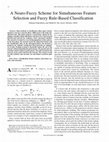
Neural Networks, IEEE Transactions …, 2004
Most methods of classification either ignore feature analysis or do it in a separate phase, offli... more Most methods of classification either ignore feature analysis or do it in a separate phase, offline prior to the main classification task. This paper proposes a neuro-fuzzy scheme for designing a classifier along with feature selection. It is a four-layered feed-forward network for realizing a fuzzy rule-based classifier. The network is trained by error backpropagation in three phases. In the first phase, the network learns the important features and the classification rules. In the subsequent phases, the network is pruned to an "optimal" architecture that represents an "optimal" set of rules. Pruning is found to drastically reduce the size of the network without degrading the performance. The pruned network is further tuned to improve performance. The rules learned by the network can be easily read from the network. The system is tested on both synthetic and real data sets and found to perform quite well.
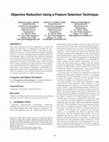
Proceedings of the 10th …, 2008
This paper introduces two new algorithms to reduce the number of objectives in a multiobjective p... more This paper introduces two new algorithms to reduce the number of objectives in a multiobjective problem by identifying the most conflicting objectives. The proposed algorithms are based on a feature selection technique proposed by Mitra et. al. . One algorithm is intended to determine the minimum subset of objectives that yields the minimum error possible, while the other finds a subset of objectives of a given size that yields the minimum error. To validate these algorithms we compare their results against those obtained by two similar algorithms recently proposed. The comparative study shows that our algorithms are very competitive with respect to the reference algorithms. Additionally, our approaches require a lower computational time. Also, in this study we propose to use the inverted generational distance to evaluate the quality of a subset of objectives.
Fast Software Encryption, 2008
HCTR was proposed by Wang, Feng and Wu in 2005. It is a mode of operation which provides a tweaka... more HCTR was proposed by Wang, Feng and Wu in 2005. It is a mode of operation which provides a tweakable strong pseudorandom permutation. Though HCTR is quite an efficient mode, the authors showed a cubic security bound for HCTR which makes it unsuitable for applications where tweakable strong pseudorandom permutations are required. In this paper we show that HCTR has a better security bound than what the authors showed. We prove that the distinguishing advantage of an adversary in distinguishing HCTR and its inverse from a random permutation and its inverse is bounded above by 4.5σ 2 /2 n , where n is the block-length of the block-cipher and σ is the number of n-block queries made by the adversary (including the tweak).

Neural Networks, IEEE Transactions …, 2003
The response of a multilayered perceptron (MLP) network on points which are far away from the bou... more The response of a multilayered perceptron (MLP) network on points which are far away from the boundary of its training data is generally never reliable. Ideally a network should not respond to data points which lie far away from the boundary of its training data. We propose a new training scheme for MLPs as classifiers, which ensures this. Our training scheme involves training subnets for each class present in the training data. Each subnet can decide whether a data point belongs to a certain class or not. Training each subnet requires data from the class which the subnet represents along with some points outside the boundary of that class. For this purpose we propose an easy but approximate method to generate points outside the boundary of a pattern class. The trained subnets are then merged to solve the multiclass classification problem. We show through simulations that an MLP trained by our method does not respond to points which lies outside the boundary of its training sample. Also, our network can deal with overlapped classes in a better manner. In addition, this scheme enables incremental training of an MLP, i.e., the MLP can learn new knowledge without forgetting the old knowledge.
International Journal of Intelligent …, 2000
The mountain method of clustering and its relative, the subtractive clustering method, are studie... more The mountain method of clustering and its relative, the subtractive clustering method, are studied here. A scheme to improve the accuracy of the prototypes obtained by the mountain method is proposed. Finally the mountain circular shell method to detect circular shells by using ...
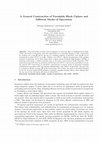
Information Security and Cryptology, 2006
This work builds on earlier work by Rogaway at Asiacrypt 2004 on tweakable block cipher (TBC) and... more This work builds on earlier work by Rogaway at Asiacrypt 2004 on tweakable block cipher (TBC) and modes of operations. Our first contribution is to generalize Rogaway's TBC construction by working over a ring R and by the use of a masking sequence of functions. The ring R can be instantiated as either GF (2 n ) or as Z Z2n . Further, over GF (2 n ), efficient instantiations of the masking sequence of functions can be done using either a binary Linear Feedback Shift Register (LFSR); a powering construction; a cellular automata map; or by using a word oriented LFSR. Rogaway's TBC construction was built from the powering construction over GF (2 n ). Our second contribution is to use the general TBC construction to instantiate constructions of various modes of operations including authenticated encryption (AE) and message authentication code (MAC). In particular, this gives rise to a family of efficient one-pass AE mode of operation. Out of these, the mode of operation obtained by the use of word oriented LFSR promises to provide a masking method which is more efficient than the one used in the well known AE protocol called OCB. 3
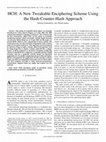
Information Theory, IEEE …, 2008
The notion of tweakable block ciphers was formally introduced by Liskov-Rivest-Wagner at Crypto 2... more The notion of tweakable block ciphers was formally introduced by Liskov-Rivest-Wagner at Crypto 2002 (the 2002 Annual International Cryptology Conference). The extension and the first construction, called CMC, of this notion to tweakable enciphering schemes which can handle variable length messages was given by Halevi-Rogaway at Crypto 2003. In this paper, we present HCH, which is a new construction of such a scheme. The construction uses two universal hash computations with a counter mode of encryption in-between. This approach was first proposed by McGrew-Viega to build a scheme called XCB and later used by Wang-Feng-Wu, to obtain a scheme called HCTR. A unique feature of HCH compared to all known tweakable enciphering schemes is that HCH uses a single key, can handle arbitrary length messages, and has a quadratic security bound. An important application of a tweakable enciphering scheme is disk encryption. HCH is well suited for this application. We also describe a variant, which can utilize precomputation and makes one less block cipher call. This compares favorably to other hash-encrypt-hash-type constructions, supports better key agility and requires less key material.
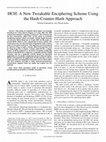
Progress in Cryptology-INDOCRYPT 2006, 2006
The notion of tweakable block ciphers was formally introduced by Liskov-Rivest-Wagner at Crypto 2... more The notion of tweakable block ciphers was formally introduced by Liskov-Rivest-Wagner at Crypto 2002 (the 2002 Annual International Cryptology Conference). The extension and the first construction, called CMC, of this notion to tweakable enciphering schemes which can handle variable length messages was given by Halevi-Rogaway at Crypto 2003. In this paper, we present HCH, which is a new construction of such a scheme. The construction uses two universal hash computations with a counter mode of encryption in-between. This approach was first proposed by McGrew-Viega to build a scheme called XCB and later used by Wang-Feng-Wu, to obtain a scheme called HCTR. A unique feature of HCH compared to all known tweakable enciphering schemes is that HCH uses a single key, can handle arbitrary length messages, and has a quadratic security bound. An important application of a tweakable enciphering scheme is disk encryption. HCH is well suited for this application. We also describe a variant, which can utilize precomputation and makes one less block cipher call. This compares favorably to other hash-encrypt-hash-type constructions, supports better key agility and requires less key material.

Fast Software Encryption, 2006
We present PEP, which is a new construction of a tweakable strong pseudo-random permutation. PEP ... more We present PEP, which is a new construction of a tweakable strong pseudo-random permutation. PEP uses a hash-encrypt-hash approach which has recently been used in the construction of HCTR. This approach is different from the encrypt-mask-encrypt approach of constructions such as CMC, EME and EME * . The general hash-encrypt-hash approach was earlier used by Naor-Reingold to provide a generic construction technique for an SPRP (but not a tweakable SPRP). PEP can be seen as the development of the Naor-Reingold approach into a fully specified mode of operation with a concrete security reduction for a tweakable strong pseudo-random permutation. The security bound of HCTR which is also based on the Naor-Reingold approach is weaker than that of PEP. Compared to previous known constructions, PEP is the only construction of tweakable SPRP which uses a single key, is efficiently parallelizable and can handle an arbitrary number of blocks.
Advances in Soft Computing—AFSS 2002, 2002
Abstract. Most methods of classification either ignore feature analysis or do it in a separate ph... more Abstract. Most methods of classification either ignore feature analysis or do it in a separate phase, offline prior to the main classification task. This paper proposes a novel neuro-fuzzy scheme for classification with online feature selection. It is a four-layered feed-forward network for ...











Uploads
Papers by Debrup Chakraborty